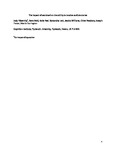The Impact of Workload on the Ability to Localize Auditory Alarms
| dc.contributor.author | Edworthy, Judy | |
| dc.contributor.author | Reid, S | |
| dc.contributor.author | Peel, K | |
| dc.contributor.author | Lock, S | |
| dc.contributor.author | Williams, J | |
| dc.contributor.author | Newbury, C | |
| dc.contributor.author | Foster, J | |
| dc.contributor.author | Farrington, M | |
| dc.date.accessioned | 2018-05-12T14:35:40Z | |
| dc.date.issued | 2018-10 | |
| dc.identifier.issn | 0003-6870 | |
| dc.identifier.issn | 1872-9126 | |
| dc.identifier.uri | http://hdl.handle.net/10026.1/11499 | |
| dc.description.abstract |
Very little is known about people's ability to localize sound under varying workload conditions, though it would be expected that increasing workload should degrade performance. A set of eight auditory clinical alarms already known to have relatively high localizability (the ease with which their location is identified) when tested alone were tested in six conditions where workload was varied. Participants were required to indicate the location of a series of alarms emanating at random from one of eight speaker locations. Additionally, they were asked to read, carry out mental arithmetic tasks, be exposed to typical ICU noise, or carry out either the reading task or the mental arithmetic task in ICU noise. Performance in the localizability task was best in the control condition (no secondary task) and worst in those tasks which involved both a secondary task and noise. The data does therefore demonstrate the typical pattern of increasing workload affecting a primary task in an area where there is little data. In addition, the data demonstrates that performance in the control condition results in a missed alarm on one in ten occurrences, whereas performance in the heaviest workload conditions results in a missed alarm on every fourth occurrence. This finding has implications for the understanding of both 'inattentional deafness' and 'alarm fatigue' in clinical environments. | |
| dc.format.extent | 88-93 | |
| dc.format.medium | Print-Electronic | |
| dc.language | en | |
| dc.language.iso | en | |
| dc.publisher | Elsevier | |
| dc.subject | Auditory alarms | |
| dc.subject | Clinical alarms | |
| dc.subject | Clinical safety | |
| dc.subject | Patient safety | |
| dc.subject | Auditory processes | |
| dc.subject | Alarm fatigue | |
| dc.title | The Impact of Workload on the Ability to Localize Auditory Alarms | |
| dc.type | journal-article | |
| dc.type | Article | |
| plymouth.author-url | https://www.webofscience.com/api/gateway?GWVersion=2&SrcApp=PARTNER_APP&SrcAuth=LinksAMR&KeyUT=WOS:000436914400009&DestLinkType=FullRecord&DestApp=ALL_WOS&UsrCustomerID=11bb513d99f797142bcfeffcc58ea008 | |
| plymouth.volume | 72 | |
| plymouth.publication-status | Published | |
| plymouth.journal | Applied Ergonomics | |
| dc.identifier.doi | 10.1016/j.apergo.2018.05.006 | |
| plymouth.organisational-group | /Plymouth | |
| plymouth.organisational-group | /Plymouth/Faculty of Health | |
| plymouth.organisational-group | /Plymouth/Research Groups | |
| plymouth.organisational-group | /Plymouth/Research Groups/Centre for Brain, Cognition and Behaviour (CBCB) | |
| plymouth.organisational-group | /Plymouth/Research Groups/Centre for Brain, Cognition and Behaviour (CBCB)/Behaviour | |
| plymouth.organisational-group | /Plymouth/Users by role | |
| dc.publisher.place | England | |
| dcterms.dateAccepted | 2018-05-12 | |
| dc.rights.embargodate | 2019-5-18 | |
| dc.identifier.eissn | 1872-9126 | |
| dc.rights.embargoperiod | Not known | |
| rioxxterms.versionofrecord | 10.1016/j.apergo.2018.05.006 | |
| rioxxterms.licenseref.uri | http://www.rioxx.net/licenses/all-rights-reserved | |
| rioxxterms.licenseref.startdate | 2018-10 | |
| rioxxterms.type | Journal Article/Review |


